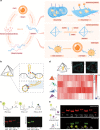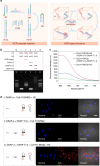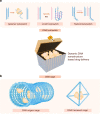Prospects and challenges of dynamic DNA nanostructures in biomedical applications
- PMID: 35606345
- PMCID: PMC9125017
- DOI: 10.1038/s41413-022-00212-1
Prospects and challenges of dynamic DNA nanostructures in biomedical applications
Abstract
The physicochemical nature of DNA allows the assembly of highly predictable structures via several fabrication strategies, which have been applied to make breakthroughs in various fields. Moreover, DNA nanostructures are regarded as materials with excellent editability and biocompatibility for biomedical applications. The ongoing maintenance and release of new DNA structure design tools ease the work and make large and arbitrary DNA structures feasible for different applications. However, the nature of DNA nanostructures endows them with several stimulus-responsive mechanisms capable of responding to biomolecules, such as nucleic acids and proteins, as well as biophysical environmental parameters, such as temperature and pH. Via these mechanisms, stimulus-responsive dynamic DNA nanostructures have been applied in several biomedical settings, including basic research, active drug delivery, biosensor development, and tissue engineering. These applications have shown the versatility of dynamic DNA nanostructures, with unignorable merits that exceed those of their traditional counterparts, such as polymers and metal particles. However, there are stability, yield, exogenous DNA, and ethical considerations regarding their clinical translation. In this review, we first introduce the recent efforts and discoveries in DNA nanotechnology, highlighting the uses of dynamic DNA nanostructures in biomedical applications. Then, several dynamic DNA nanostructures are presented, and their typical biomedical applications, including their use as DNA aptamers, ion concentration/pH-sensitive DNA molecules, DNA nanostructures capable of strand displacement reactions, and protein-based dynamic DNA nanostructures, are discussed. Finally, the challenges regarding the biomedical applications of dynamic DNA nanostructures are discussed.
© 2022. The Author(s).
Conflict of interest statement
The authors declare no competing interests.
Figures







References
-
- Seeman NC, Sleiman HF. DNA nanotechnology. Nat. Rev. Mater. 2017;3:17068. doi: 10.1038/natrevmats.2017.68. - DOI
Publication types
LinkOut - more resources
Full Text Sources

